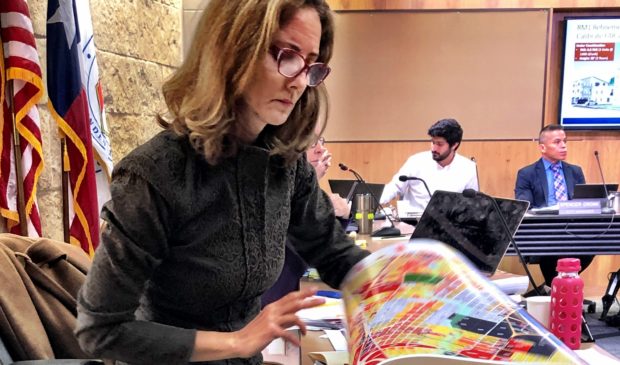Council argues over adopting zoning map
Tuesday, November 19, 2019 by
Jo Clifton City Council still has at least two more work sessions and a public hearing in which to understand and hash out differences of opinion about the new Land Development Code before Dec. 9, the first of three readings to adopt it. Mayor Steve Adler noted during Monday’s work session that second reading of the ordinance would likely not take place until February 2020.
Although Council has reached agreement on a number of important features of the new code, including the need to make room for thousands of more modest homes, there are significant differences of opinion about one aspect of the adoption – the all-important map showing which properties fall into which zoning categories. Council Member Ann Kitchen is particularly adamant about not adopting a new map until staff and consultants have incorporated the changes proposed by Council and the public.
After Monday’s meeting, Kitchen told the Austin Monitor she thought she and her colleagues had a good discussion about process, but she was still concerned about adoption of the zoning map. She said it was especially important to be clear with the public about their process, especially with regard to the map. “Because we promised people that they would have an opportunity to suggest changes – within our goals.”
Kitchen said many people had weighed in with suggested changes but the city has not told them how they might or might not incorporate those changes. She said Council has not seen any maps that included changes suggested by the public, nor have they received an analysis of how those changes might impact the city’s overall goals. Those goals include providing more housing and getting people out of their cars and onto public transportation.
There are also significant differences of opinion about the role that developers play in increasing the city’s housing stock – whether it is generally productive or generally contrary to the best interests of homeowners.
Council Member Pio Renteria shared a story about a friend who had built an accessory dwelling unit and then sold his original house and property for $350,000, enabling him to stay in the smaller unit at the back of his property.
Council Member Alison Alter told her colleagues, “I just want us to make sure that as we’re thinking about the code, we’re thinking about who we’re developing incentives for. Developers build houses after they displace the occupants who live there. So we need programs that create opportunities for the existing occupants to build ADUs or take advantage of the ADUs being built.”
Mayor Pro Tem Delia Garza called Alter’s remarks “hyperbole.” She described a recent case in her district to rezone a property where no one was living. “And there is a developer that is wanting to build units there to create housing,” as well as developers who help people build ADUs, she said.
Alter did not respond to Garza’s comment, but Kitchen defended her, saying it was not hyperbole, simply a difference of perspective. After the meeting, Alter said she was happy to see that modeling and discussions of commuting are leading to some important changes to FAR (floor area ratio), as well as the preservation bonus. “We’re really far off of where we need to be right now in the current draft. So I’m pleased that those are moving in the right direction.”
Alter said the current draft incentivizes larger units, “and we’re incentivizing a lot of demolitions that don’t need to happen and we are creating a lot of loopholes that we’ll be fixing for the next 30 years.” There is also a lot in the code that Council does not understand, Alter said.
Garza also said she did not want adoption of the new ordinance to devolve into anything like budget adoption, with its many last-minute votes on additions. Her comments fell in line with Mayor Adler’s description of trying to limit the scope of changes Council might make during first reading as outlined on the City Council Message Board.
Council Member Jimmy Flannigan said he agreed with Garza about developers performing useful work. Making it easier to develop in the West Campus area has decreased pressure on homeowners in the area, he said. After the meeting, Flannigan said he was pleased with how things were moving on adoption of the new code.
Council Member Paige Ellis asked staff what was being done to simplify the process for developing an ADU. Brent Lloyd, an attorney working on revamping the Land Development Code, told Ellis his department was working on the question, but it was more related to city processes than to changing the code.
Photo by Jo Clifton: Council Member Kathie Tovo studies the new zoning map.
The Austin Monitor’s work is made possible by donations from the community. Though our reporting covers donors from time to time, we are careful to keep business and editorial efforts separate while maintaining transparency. A complete list of donors is available here, and our code of ethics is explained here.
You're a community leader
And we’re honored you look to us for serious, in-depth news. You know a strong community needs local and dedicated watchdog reporting. We’re here for you and that won’t change. Now will you take the powerful next step and support our nonprofit news organization?



